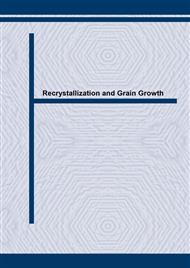p.1199
p.1205
p.1211
p.1217
p.1223
p.1229
p.1237
p.1243
p.1251
The Effect of Hydrogen on Dynamic Recrystallization in α-Titanium Alloys
Abstract:
The influence of hydrogen content on the mechanical properties and size of dynamically recrystallized grains in commercially pure (CP) titanium and Ti-5Al-2.5Sn alloy was investigated. The alloys with hydrogen contents from 0.1 to 5.2 at.% were deformed in the a-field at temperatures of 650°, 750°С with initial strain rates of 5×10-4 s-1. A decrease of the deformation temperature leads to a reduction in grain size and to a stress increase for all compositions. This is in good agreement with the well known relation between the recrystallized grain size (d) and the steady flow stress ss=kd-n. At a given test temperature the steady state flow stress is four times lower and the grain size is about ten times greater in CP titanium in comparison with the Ti-5Al- 2.5Sn alloy. Hydrogen alloying of the Ti-5Al-2.5Sn alloy does not lead to a noticeable change in ss and d. However, an increase in hydrogen content from 0.1 to 5.2 at.% in CP titanium leads not only to a decrease in grain size by a factor of 2 but also to a decrease in flow stress (about 28%). This result is not in agreement with the above relation. This unusual behaviour may be due to two reasons: the influence of hydrogen on grain growth and the hydrogen effect on dynamic strain ageing. Both these effects are stronger in CP titanium.
Info:
Periodical:
Pages:
1223-1228
Citation:
Online since:
October 2004
Price:
Сopyright:
© 2004 Trans Tech Publications Ltd. All Rights Reserved
Share:
Citation:


